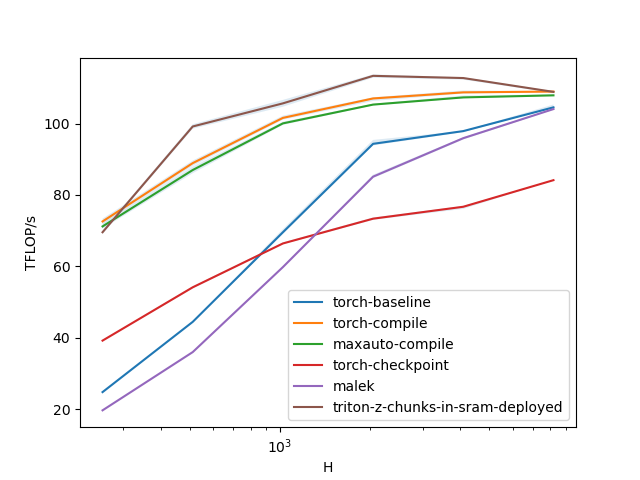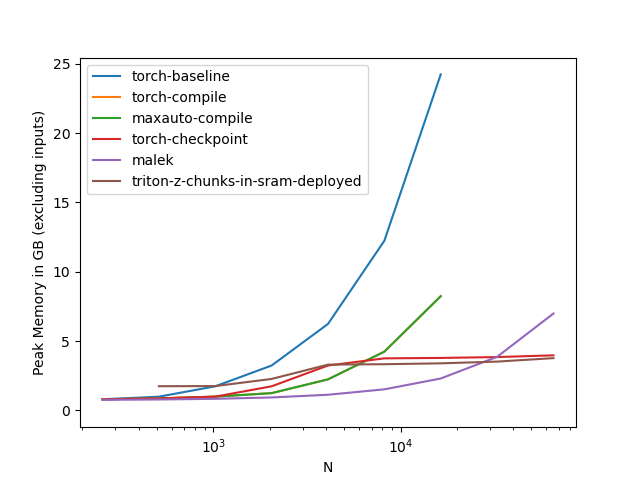This is a fused implementation that combines torch.nn.Linear layer and torch.nn.CrossEntropLoss into a single module.
This kind of fused implementation can save a lot of activation memory, especially in usecases in language modeling where sequence lengths or batch sizes are long
and vocabulary sizes are massive. Compared to a baseline implementation, which may materialize 2-3 tensors of size batch_size x seq_length x vocabulary_size x 4, this module will only materialize a single tensor of size
N_chunk_size x vocabulary_size x 4 bytes at its peak. N_chunk_size is a user-controlled variable.
As an additional benefit, the implementation is a bit more careful about floating point operations and, in my tests, noticeably more accurate
than the baseline, without being slower (see benchmarks shown below and in the bench folders).
This solution owes a lot to the implementation of mgmalek, which is posted here: https://github.com/mgmalek/efficient_cross_entropy.
You can think of this implementation as a more feature-complete version of the same chunking strategy, with gains through additional fusions
of everything else into matrix multiplication prologues/epilogues, and some changes to preserve accuracy. The whole thing was written after reading
pytorch/pytorch#124480, which contains a lot of interesting input from YouJiacheng and from the PyTorch team.
I somewhat assume that this kind of performance optimization will eventually be entirely subsumed by improvements to torch.compile.
>>> from linear_cross_entropy import LinearCrossEntropyLoss
>>> module = LinearCrossEntropyLoss(2048, 16384).cuda().half()
>>> x = torch.randn(4, 512, 2048, dtype=torch.float16, device=torch.device("cuda"))
>>> y = torch.randint(0, 16384, (4, 512), device=torch.device("cuda"), dtype=torch.long)
>>> loss = module(x, y)
LinearCrossEntropyLoss applies a linear transformation to the incoming data z = xA^T and then immediately
computes the cross entropy loss of z with a tensor of labels y, L(z, y), which it returns as a scalar value.
- All dimensions need to be divisible by sufficiently large powers of 2
- This works only on devices where triton works.
- Monitoring is optional and turned off by default.
- Speed-ups over a compiled torch baseline only materialize in float 16 with sufficiently large vocabulary sizes / numbers of classes or very long sequences or batch sizes.
- This module is an instance of
nn.Linearto pick up initialization calls tonn.Linear, but the weight matrix is transposed compared to normalnn.Linearlayers. - This function will call a (substantial) triton autotune list the first time it is called. You can reduce or change the number of evaluated
configs by modifying
linear_cross_entropy.fwd_configsandlinear_cross_entropy.bwd_configs. - Be careful when auto-casting this module. Right now, the code default to auto-casting to
float16. This might not be what you need. - If you want to use this module for inference, you should re-enable checks so that the backward function only triggers if
weight.requires_gradisTrue. (I didn't do this by default because it is incompatible withautocast.)
If you observe
raise OutOfResources(self.metadata.shared, max_shared, "shared memory")
triton.runtime.errors.OutOfResources: out of resource: shared memory, Required: 131072, Hardware limit: 101376. Reducing block sizes or `num_stages` may help.
then one of the auto-tuned block configurations does not fit onto your card. This is very possible if you use a non-standard GPU. To fix this, enable print-outs of the current configuration (look for the tl.static_print statements) and then disable the offending auto-tune configurations (or add new ones that fit your device better).
If you observe issues related to custom_fwd, then this is related to the torch.autocast decorators. If you don't use autocast, you can safely remove the decorators on the forward and backward pass.
Setting LinearCrossEntropyLoss(2048, 16384).monitoring = True will additionally accumulate a number of monitoring
variables as a dictionary in module.metrics. These are
- Logit Norm
- Maximal logit value
- Logit Entropy
- z-regularization value.
Note: norm and entropy values are a constant away from what you might expect.
in_features: hidden size of each input sampleout_features: size of each output sample (this will be vocabulary size / number of classes)ignore_index: Which label index to ignore (as in normal CrossEntropyLoss) [Default: -1]logit_scale: Whether to scale the logits before the loss computations [Default: 1.0]z_regularization: Whether to include z regularization (minimizing logsumexp(x)) [Default: 0.0]N_chunk_size: How fine to chunk the leading dimensions. The peak memory load will be N_chunk_size x out_features x 4 bytes [Default 4096]init_method: This is an optional callable initialization function [Default: None]
- Input
x(input embeddings): :math:(*, H_{in})where :math:*means any number of dimensions including none and :math:H_{in} = \text{in\_features}. - Input
y(labels): :math:(*)This should be atorch.longtensor with the same number of elements,(*), as the input embeddings. - Output: :math:
(1,)This function always returns the fully reduced loss.
weight: the learnable weights of the module of shape :math:(\text{in\_features}, \text{out\_features}). The values are initialized from :math:\mathcal{N}_text{trunc}(1/ \sqrt{k}), where :math:k = \frac{1}{\text{in\_features}}
You can also directly use the functional version as linear_cross_entropy(x,y)
There are a ton of benchmarks of speed (in bench), memory (in bench-mem) and accuracy (in bench-acc). Take a look!
The benchmarking script is bench_fusions.py.
For reference, the benchmarked version of torch.compile is the nightly from the 15th of July, 2024.
This solution of "z/logit chunks in SRAM" is still quite unsatisfying to me. I would have prefered not to ever materialize the logits in
main memory, but have so far failed to find a scalable solution to that end. You can find a graveyard of bad alternatives in the variants
folder. The problem that I've run into is that the hidden dimensions I care about are to large to keep large chunks cached, leading to
extensive traffic to and from the cache that kills performance.


